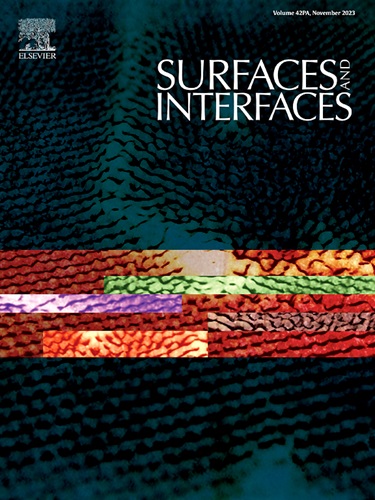A strategy for fabricating high-strength polyimide/carbon nanotube composite aerogels with efficient electromagnetic interference shielding efficacy in the X-band using nanofiber reinforcement
IF 5.7
2区 材料科学
Q2 CHEMISTRY, PHYSICAL
引用次数: 0
Abstract
In the aerospace field, the intricate working conditions impose stringent requirements on the application of electromagnetic interference (EMI) shielding materials. Such materials not only need to fulfill the EMI shielding performance criteria but also must possess the capability to endure high temperature and exhibit favorable mechanical property. In the present study, anisotropic composite aerogels were fabricated through directional freezing and thermal imidization, with polyimide (PI) serving as the foundational matrix, polyimide nanofibers (PINF) functioning as reinforcements and incorporating multi-walled carbon nanotubes (MWCNTs). These composite aerogels demonstrated remarkable thermal stability, with the weight loss of 5 % up to 565 °C, along with excellent flame retardancy. The incorporation of PINF served to interconnect the internal structure of the aerogels, enhancing the mechanical property, as evidenced by an elastic modulus reaching up to 275 KPa. Furthermore, the EMI shielding performance of anisotropic composite aerogels was also systematically analyzed. The average shielding effectiveness (SET) of the 9-mm-thick aerogel (PPC-1) within the X-band attained 79.7 dB in the vertical direction and 61.2 dB in the horizontal direction, signifying excellent EMI resistance. These composite aerogels hold great promise for application in the demanding aerospace industry characterized by complex environments. Overall, this study provides a novel approach for preparing composite aerogels possessing lightweight, high-strength and high-efficiency EMI shielding performance, thereby making a valuable contribution to the relevant research field.
利用纳米纤维增强制备高强度屏蔽x波段电磁干扰的聚酰亚胺/碳纳米管复合气凝胶
在航空航天领域,复杂的工作条件对电磁干扰屏蔽材料的应用提出了严格的要求。这种材料不仅需要满足电磁干扰屏蔽性能标准,还必须具有耐高温的能力和良好的机械性能。本研究以聚酰亚胺(PI)为基础基质,聚酰亚胺纳米纤维(PINF)作为增强材料,并加入多壁碳纳米管(MWCNTs),通过定向冷冻和热亚酰化制备各向异性复合气凝胶。这些复合气凝胶表现出显著的热稳定性,在565°C时,重量损失5%,同时具有优异的阻燃性。pif的加入有助于连接气凝胶的内部结构,增强其力学性能,弹性模量高达275 KPa。此外,还系统分析了各向异性复合气凝胶的电磁干扰屏蔽性能。9 mm厚气凝胶(PPC-1)在x波段的平均屏蔽效能(SET)在垂直方向上达到79.7 dB,在水平方向上达到61.2 dB,具有良好的抗EMI性能。这些复合气凝胶在复杂环境要求苛刻的航空航天工业中具有很大的应用前景。总之,本研究为制备轻质、高强、高效的电磁干扰屏蔽复合气凝胶提供了一条新途径,为相关领域的研究做出了重要贡献。
本文章由计算机程序翻译,如有差异,请以英文原文为准。
求助全文
约1分钟内获得全文
求助全文
来源期刊

Surfaces and Interfaces
Chemistry-General Chemistry
CiteScore
8.50
自引率
6.50%
发文量
753
审稿时长
35 days
期刊介绍:
The aim of the journal is to provide a respectful outlet for ''sound science'' papers in all research areas on surfaces and interfaces. We define sound science papers as papers that describe new and well-executed research, but that do not necessarily provide brand new insights or are merely a description of research results.
Surfaces and Interfaces publishes research papers in all fields of surface science which may not always find the right home on first submission to our Elsevier sister journals (Applied Surface, Surface and Coatings Technology, Thin Solid Films)
 求助内容:
求助内容: 应助结果提醒方式:
应助结果提醒方式:


